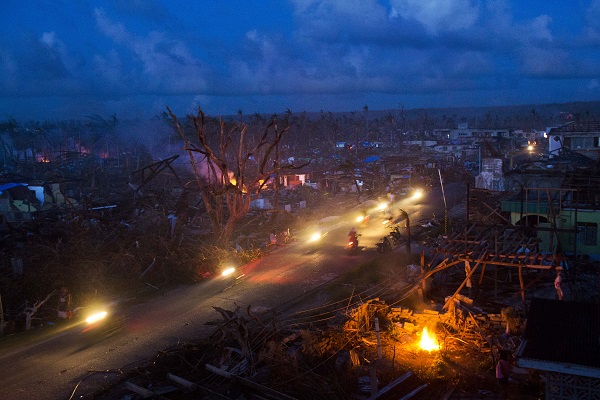Moody’s says PH fundamentals intact

Supertyphoon “Yolanda” (Haiyan) survivors ride motorbikes through the ruins of the destroyed town of Guiuan, Philippine, on Thursday, Nov. 14, 2013. Yolanda killed thousands and caused billions of pesos in damage, but international rating agency Moody’s Investor Service said the Philippines’ economic fundamentals remained intact. AP Photo/David Guttenfelder, File)
Supertyphoon “Yolanda” killed thousands and caused billions of pesos in damage, but a major international rating agency said the Philippines’ economic fundamentals remained intact.
Moody’s Investor Service in a report this week said Supertyphoon Yolanda may be the worst calamity to hit Southeast Asia in nearly a decade, rivaled in scale only by the 2004 Indian Ocean tsunami that struck Indonesia.
However, while the loss in human lives was overwhelming, the overall effect on the real economy was likely to be muted.
“The 2004 Indian Ocean tsunami that struck Indonesia could be most similar to Typhoon Yolanda (international name: Haiyan) in terms of the scale of devastation, but it, too, had a limited effect on overall economic conditions,” Moody’s said.
Moody’s said the local economies of Leyte and other provinces in the Visayas hit hard by Yolanda last week would take the brunt of the impact.
Article continues after this advertisementThe damage to road infrastructure, power lines, communications systems, and farmlands would likely lead to a steep drop in output.
Article continues after this advertisementMoody’s noted that, as of Wednesday morning, the National Disaster Risk Reduction and Management Council’s running count of casualties showed 1,833 deaths.
The rating firm, which upgraded the Philippines to “investment grade” last October, cited the government’s own initial estimate that the damage brought by Yolanda would shave just half a percentage point off the country’s estimated growth for 2013.
“The relatively small hit to growth reflects the small contribution of Region VIII to the country’s economic output,” Moody’s said.
In 2012, Region VIII accounted for only 2.2 percent of the Philippines’ gross domestic product (GDP), down from 2.7 percent in 2009.
In the same year, Region VIII’s real gross regional domestic product (GRDP) contracted by 6.2 percent and subtracted 0.2 percentage points from the country’s 6.8 percent growth rate.
The most important regions in terms of their contribution to Philippine GDP, Moody’s said, were Metro Manila and the Southern Tagalog region, which together constituted 53 percent of GDP in 2012.
Fortunately, these areas were unaffected by Yolanda.
Moody’s expects the Philippine economy to grow by 7 percent this year, matching the top end of the government’s official forecast.
The asset quality of rated Philippine banks will also be minimally affected.
As of the end of 2012, loans to Region VIII constituted only 0.4 percent of total system loans.
Moody’s also expressed confidence that the Philippine government would be able to adequately finance out of its own coffers the reconstruction in typhoon-affected areas.
The government registered a primary surplus of P156.9 billion through the first three quarters of this year, 12.7 percent more than the balance in the same period in 2012.
In its annual budget, the government had provisioned P7.5 billion in a calamity fund, as well as embedded P3.9 billion in quick response funds in budgets for different line agencies, “although some of these funds had already been spent to address earlier disasters,” Moody’s said.
“President Aquino also has discretionary funds available at his disposal. In addition, assistance from the international community will mitigate stresses on the government’s fiscal position.”